So that with the onset of winter it is always warm and comfortable in advance ...
|
|
The long -awaited summer came, and many citizens hurry to summer cottages, gardens and sites to ... |
Construction of a cottage is always a comprehensive process, divided into several ... |
How to glue liquid wallpaper
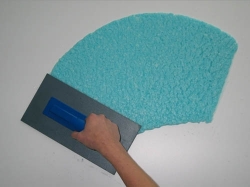
Liquid wallpaper quickly broke into the market of finishing materials and also rapidly won the hearts of millions of housewives around the world. They are surprisingly beautiful, practical and environmentally friendly. They are easy to glue, unless, of course, this word can be applied to the method of applying liquid wallpaper to the walls, they simply take care of them. In general, this material deserves a huge number of praises in your address. However, many are afraid to contact liquid wallpaper. And why? Because they know little about them and already do not know how to glue liquid wallpaper. But everything is much simpler than it might seem.
Content:
- What are liquid wallpaper?
- Advantages of liquid wallpaper
- Disadvantages of liquid wallpaper
- How to glue liquid wallpaper correctly?
- Preparation of walls
- Preparation of the mixture
- Applying liquid wallpaper to the walls
What are liquid wallpaper?
Before you learn about how to properly glue liquid wallpaper, you should get acquainted with their composition, properties, advantages and disadvantages.
Liquid wallpaper is a plastic material in its structure very similar to flakes or sawdust. It is sold in transparent plastic bags weighing 1 kilogram. The composition of such finishing material includes natural cellulose or cotton fibers, acrylic components, adhesive composition and dyes. In addition, other ingredients can be found in the package: sparkles, mica, silk fibers, quartz crumbs, gold and silver threads.
After drying, the composition turns into something reminiscent in its texture solid foam: the surface of the walls is the same rough, soft and warm.
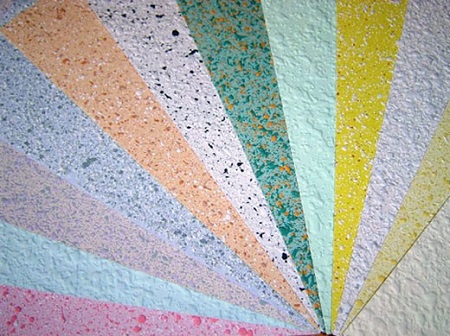
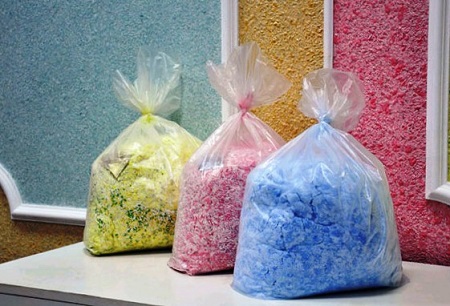
There are several types of liquid wallpaper, and they do not have any special differences, except that according to the thickness of the finished layer, we can conclude about what type of material was used in the repair. Some are thin and smooth, having a dense, but not too textured surface, other voluminous with clearly noticeable ravings are more similar to the fabric.
Advantages of liquid wallpaper
- Since there are only natural components with a neutral electric charge in the composition of liquid wallpaper, they have excellent antistatic properties. What does it mean? And this means that such wallpapers will not turn into a vacuumber and will create a favorable atmosphere in the room.
- Liquid wallpaper is universal. They can be used to finish the living room, bedroom, children's room, kitchen, corridor and even the bathroom.
- Such finishing material perfectly hides small defects of walls, cracks, cracks in the places of fitting skirting boards, platbands, frames, switches and sockets. In addition, they have no seams, which means that the surface of the walls always and in any weather will look perfectly flat.
- Liquid wallpaper can be finished with the walls of new apartments and not be afraid of shrinkage. They are not deformed, which allows you not to wait 3-4 years while the house isnded, but immediately start a full repair.
- Liquid wallpaper can be glued to almost all surfaces: concrete, drywall, wood, putty, plaster, fiberboard, plywood, MDF, paint and even metal.
- Such wallpapers are easily subjected to cosmetic repairs: they do not need to be torn completely from the wall, it is enough to soak the damaged or contaminated area with water and remove the mixture with a spatula. Apply a new one to the place of the old coating, to level and the wall will again delight you with beauty and impeccability.
- Liquid wallpaper breathes, they provide heat and sound insulation properties to your walls, in general, this material is ideal from all points of view.
Disadvantages of liquid wallpaper
Unfortunately, such a wonderful coating also has disadvantages, however, there are only two of them, and they can be classified as insignificant.
Liquid wallpaper is quickly washed off with water, so if you decide to finish the bathroom with them or want to periodically wipe them with a damp cloth (to maintain cleanliness), then you will have to protect the surface of the walls with a colorless varnish. The beauty of the finish will remain, however, the effect of breathing walls will disappear irretrievably.
And the second drawback is a high price, but globally speaking, beauty is much more expensive than 200 rubles per kilogram, so you can safely delete the cost of liquid wallpaper from the list of vices.
How to glue liquid wallpaper correctly?
Preparation of walls
Naturally, you need to start with the preparation of the walls. To do this, remove the remnants of old wallpaper and paints, and if there are metal objects (hats of nails, bolts, etc.), paint them with white enamel or a water -emulsion.
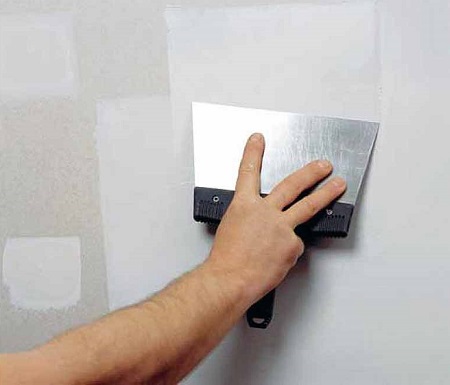
If the walls have an intense color, then it is better to get rid of it with special primers, enamel, oil paint or water -based white paint. In old houses, such as Stalino or Khrushchevs, the walls do not differ in perfect evenness and it is generally incomprehensible what they are made of, so they will need to be impregnated with a solution of FG or ordinary impregnation. After that, the surface of the walls must be painted over with water -based paint in two layers, it will protect from the appearance of yellow spots of insidious satellites of old apartments.
Gypsum cardboard will have to put it completely, and not just the joints. What for? Just after drying the liquid wallpaper, white stripes of putty will become noticeable. In addition, it will be necessary to additionally cover the walls with a water emulsion, since the putties are not waterproof and can soak during the application of liquid wallpaper. If you use gypsum putty, then you can add PVA glue to the paint in a 3: 1 proportion to strengthen the surface of the wall and will not allow it to absorb moisture.
Wooden surfaces can also absorb moisture, so before applying liquid wallpapers on them, make sure that they are not too thin (the thinner the sheet, the stronger it is deformed). To protect such surfaces, either oil paint or FG in 2-3 layers, followed by painting with a water-based, is used.
Preparation of the mixture
Pour warm water into a suitable container and gradually (in small portions) add a dry composition to the vessel, while mixing the solution with a mixer drill. As a result, you should get a mixture in your consistency, similar to a thick, terrible sour cream. All large uninvited particles are best removed when applying to the walls, these lumps will create difficulties for you.
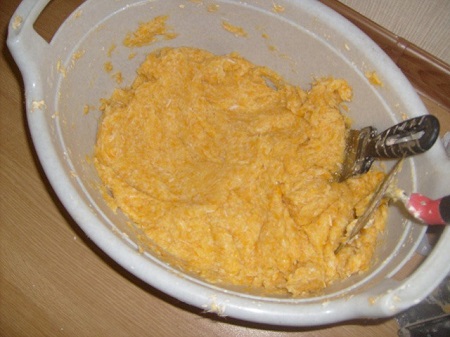
After a kneading, the solution must be left alone for 15-20 minutes, and then once again caused the same construction mixer. To achieve a homogeneous shade, prepare a mixture of several packages and knead the required amount of material in advance, since the entire prepared surface will need to be covered at one time. Not in two days, but in one!
Applying liquid wallpaper to the walls
If you do not know how to glue liquid wallpaper, the video plot about this process will help you understand all its subtleties. And after viewing, be sure to read our instructions.
So, for work you will need:
- large container for breeding dry mixture
- spatula or roller for leafing wallpaper
- sprayer if there is such an opportunity
- a hip roller with a textured relief if you want to give the surface a certain texture
- colorless varnish for the finish coating
Take a little mixture and distribute it on the surface of the wall with a spatula or roller. The wallpaper should be tightly covered with the base, there should not be any bald spots, voids and bulges. Having finished with the first section and the first portion of the mixture, go to the second, just make sure that there are no special boundaries between the neighboring already rolled sections, they must flow smoothly into each other.
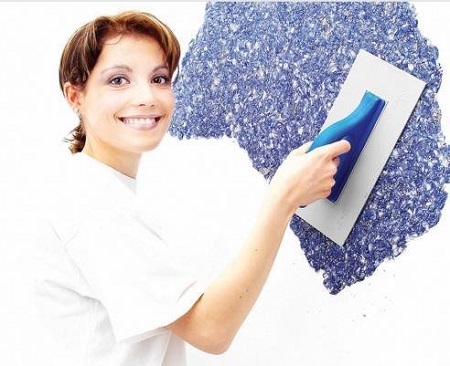
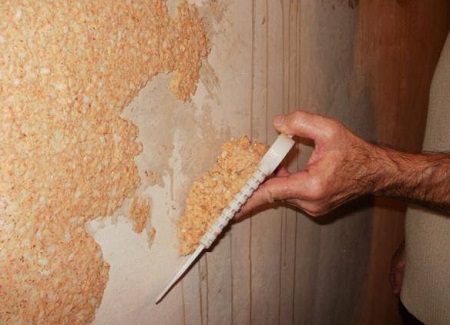
If you didn’t like something (a lump, unevenness, proplesh) have formed), then you can wet the wallpaper a little and remove the defective area, and then fill it with the mixture and smooth it again. Just do not get very carried away by adjustments to wet the wallpaper already applied to the walls no more than 3 times.
If you have a special hopper pistol for applying liquid wallpaper, then the speed of application will increase several times, but such a device is quite expensive. It can be rented if the time of repair work is limited to you. The rental price is approximately 300-400 rubles, however, a compressor will also have to be taken to the gun, which will create pressure inside the device. In this case, the rental cost will increase to 600-700 rubles per day.
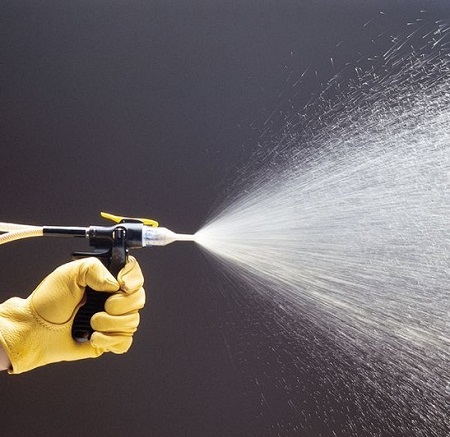
In general, the application of liquid wallpaper on the walls is not complicated, but requiring accuracy and attentiveness. Such a coating dries from 12 hours to 3 days, depending on the level of humidity and temperature in the room. It is necessary to cover the wallpaper with colorless varnish only with their complete drying, otherwise the coating can be deformed.
Liquid wallpaper is a universal finishing material with which you can create interesting interior solutions. They are perfectly combined with each other, allowing you to embody the most daring fantasies into reality: stripes and flowers, geometric shapes and ornaments. Creating and showing your creative abilities with them is not a problem.
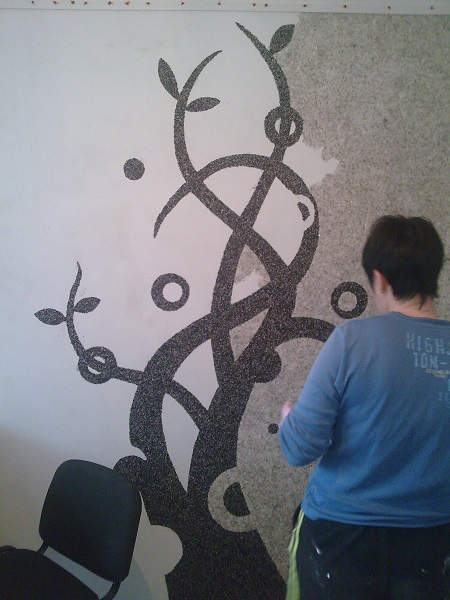
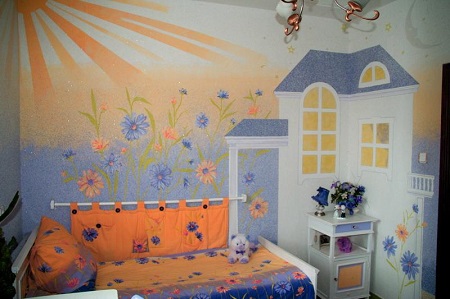
And if you are still afraid to use the new modern type of finishing materials, then in vain, because creating comfort in the apartment with the help of liquid wallpaper is easy and simple.

cool liquid wallpaper sila
cool liquid wallpaper Silk Plaster made of silk + promotion
thanks. Interesting material.
thanks. Interesting material. Instructive